Analyzing Training and Development Needs for BHP Billiton Employees
VerifiedAdded on 2021/06/17
|9
|2580
|99
Report
AI Summary
This report provides a comprehensive analysis of the training and development needs of BHP Billiton, a multinational company operating in a globalized business environment. It begins by highlighting the impact of globalization on the company, including technological advancements, changes in job regulations, and evolving business processes. The report emphasizes the importance of employee training and development to ensure the company remains competitive. It then focuses on the need for a thorough assessment of employee requirements to address the rapid changes in the business landscape. The report details various methods for conducting a needs assessment, such as interviews, work samples, and assessment surveys. It also outlines the process of determining the necessity of training, including organizational, personal, and task analyses. The report discusses the potential outcomes of a poorly planned needs assessment and concludes with recommendations for effective training and development strategies, emphasizing the importance of continuous employee skill enhancement to meet the challenges of globalization.
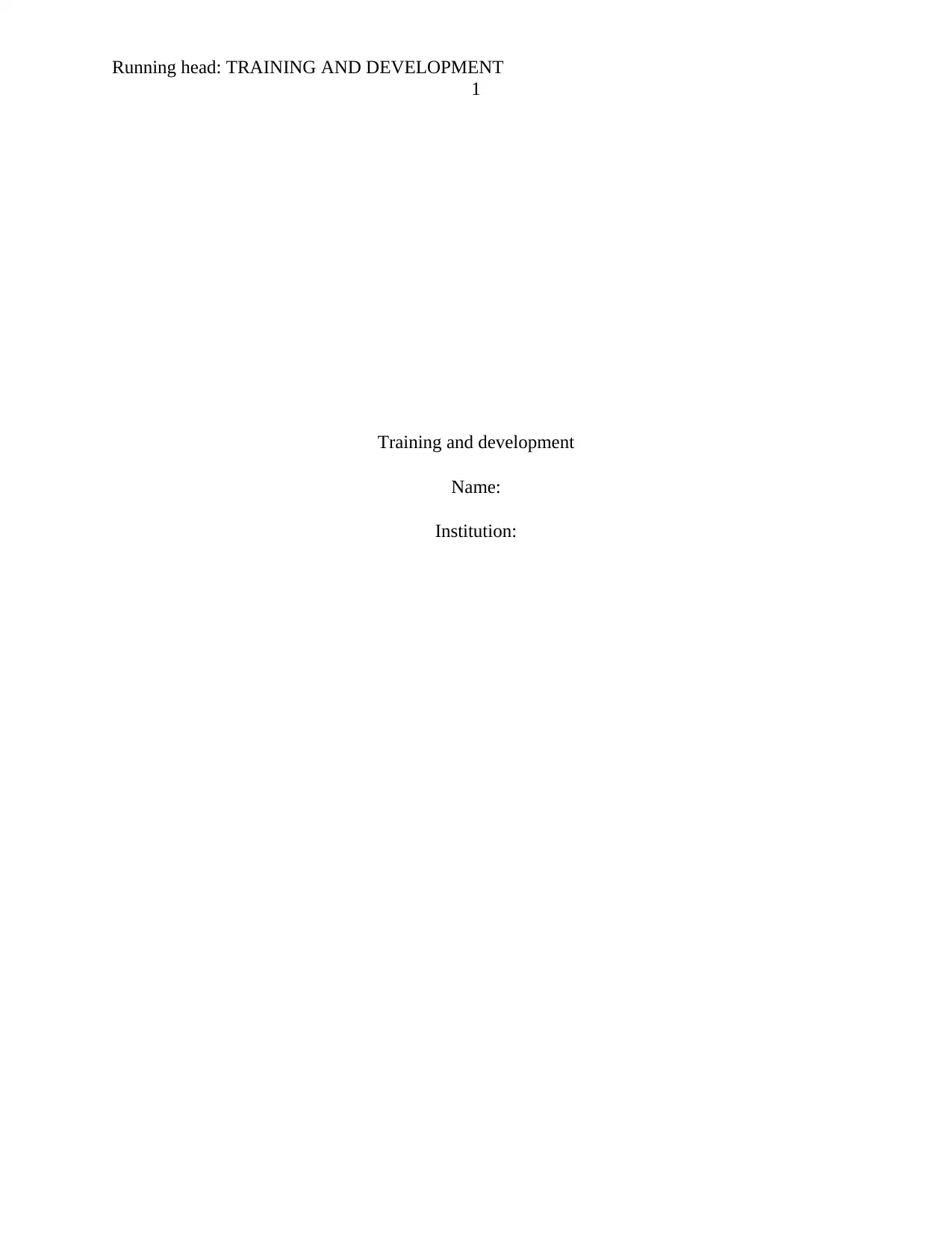
Running head: TRAINING AND DEVELOPMENT
1
Training and development
Name:
Institution:
1
Training and development
Name:
Institution:
Paraphrase This Document
Need a fresh take? Get an instant paraphrase of this document with our AI Paraphraser
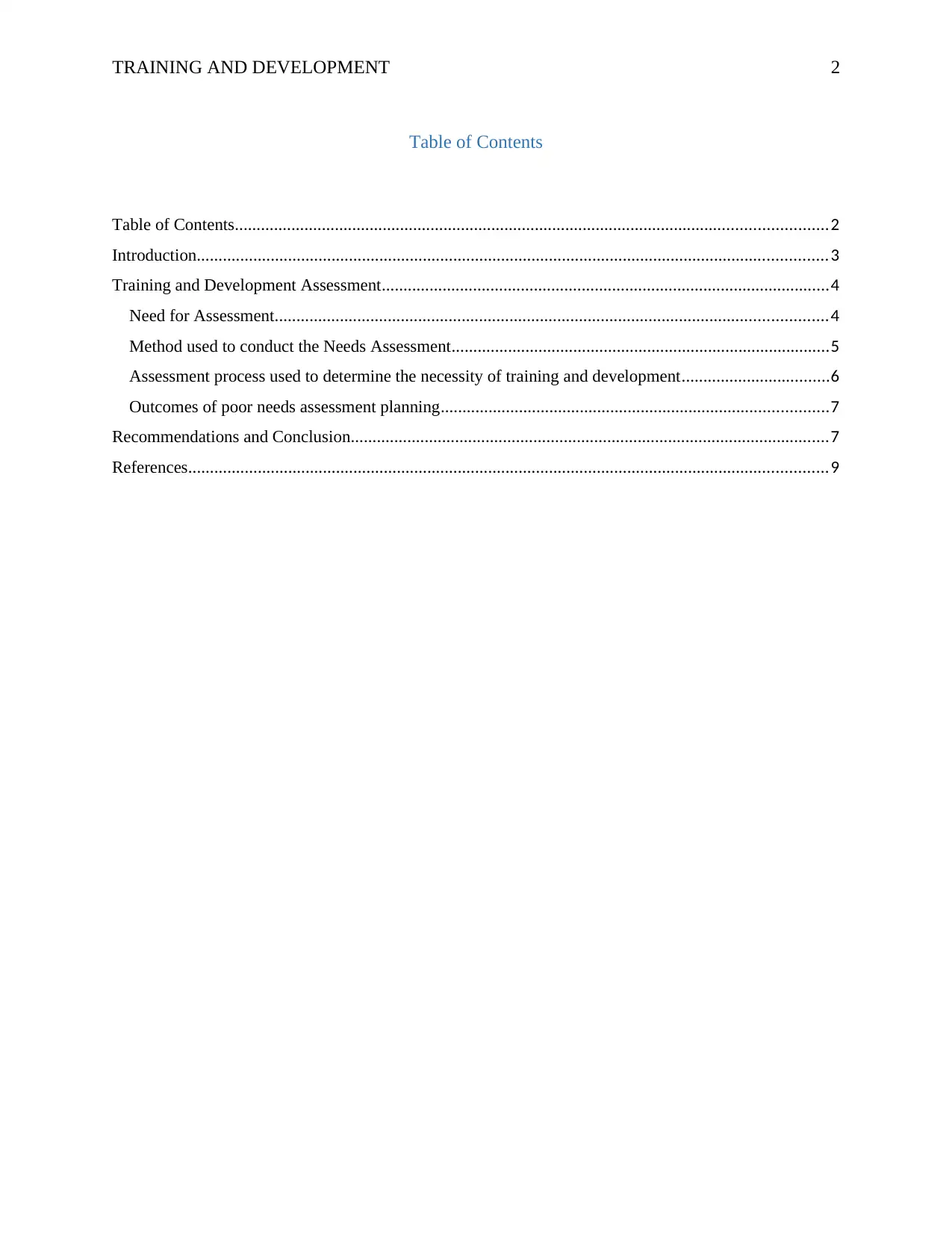
TRAINING AND DEVELOPMENT 2
Table of Contents
Table of Contents........................................................................................................................................2
Introduction.................................................................................................................................................3
Training and Development Assessment.......................................................................................................4
Need for Assessment...............................................................................................................................4
Method used to conduct the Needs Assessment.......................................................................................5
Assessment process used to determine the necessity of training and development..................................6
Outcomes of poor needs assessment planning.........................................................................................7
Recommendations and Conclusion..............................................................................................................7
References...................................................................................................................................................9
Table of Contents
Table of Contents........................................................................................................................................2
Introduction.................................................................................................................................................3
Training and Development Assessment.......................................................................................................4
Need for Assessment...............................................................................................................................4
Method used to conduct the Needs Assessment.......................................................................................5
Assessment process used to determine the necessity of training and development..................................6
Outcomes of poor needs assessment planning.........................................................................................7
Recommendations and Conclusion..............................................................................................................7
References...................................................................................................................................................9
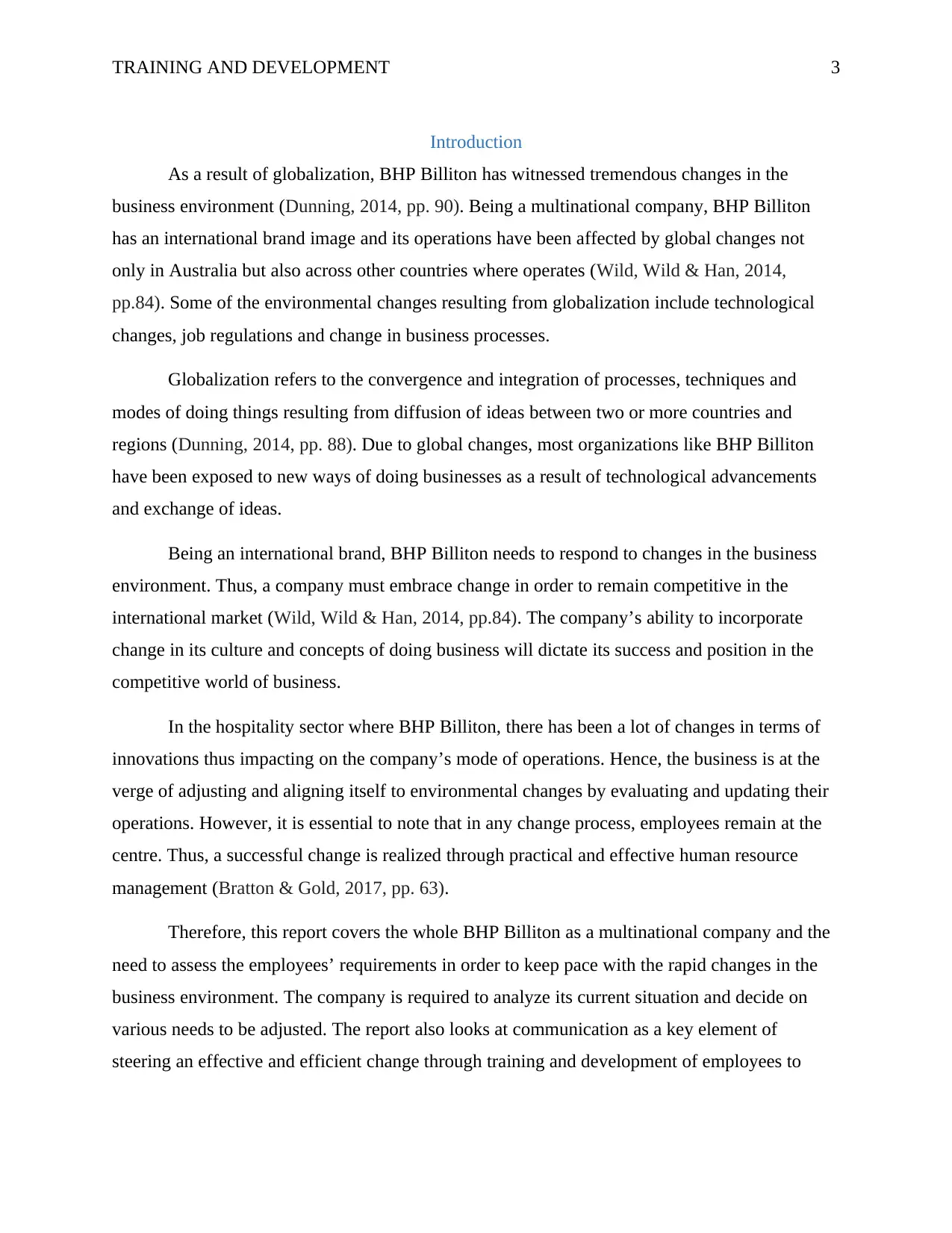
TRAINING AND DEVELOPMENT 3
Introduction
As a result of globalization, BHP Billiton has witnessed tremendous changes in the
business environment (Dunning, 2014, pp. 90). Being a multinational company, BHP Billiton
has an international brand image and its operations have been affected by global changes not
only in Australia but also across other countries where operates (Wild, Wild & Han, 2014,
pp.84). Some of the environmental changes resulting from globalization include technological
changes, job regulations and change in business processes.
Globalization refers to the convergence and integration of processes, techniques and
modes of doing things resulting from diffusion of ideas between two or more countries and
regions (Dunning, 2014, pp. 88). Due to global changes, most organizations like BHP Billiton
have been exposed to new ways of doing businesses as a result of technological advancements
and exchange of ideas.
Being an international brand, BHP Billiton needs to respond to changes in the business
environment. Thus, a company must embrace change in order to remain competitive in the
international market (Wild, Wild & Han, 2014, pp.84). The company’s ability to incorporate
change in its culture and concepts of doing business will dictate its success and position in the
competitive world of business.
In the hospitality sector where BHP Billiton, there has been a lot of changes in terms of
innovations thus impacting on the company’s mode of operations. Hence, the business is at the
verge of adjusting and aligning itself to environmental changes by evaluating and updating their
operations. However, it is essential to note that in any change process, employees remain at the
centre. Thus, a successful change is realized through practical and effective human resource
management (Bratton & Gold, 2017, pp. 63).
Therefore, this report covers the whole BHP Billiton as a multinational company and the
need to assess the employees’ requirements in order to keep pace with the rapid changes in the
business environment. The company is required to analyze its current situation and decide on
various needs to be adjusted. The report also looks at communication as a key element of
steering an effective and efficient change through training and development of employees to
Introduction
As a result of globalization, BHP Billiton has witnessed tremendous changes in the
business environment (Dunning, 2014, pp. 90). Being a multinational company, BHP Billiton
has an international brand image and its operations have been affected by global changes not
only in Australia but also across other countries where operates (Wild, Wild & Han, 2014,
pp.84). Some of the environmental changes resulting from globalization include technological
changes, job regulations and change in business processes.
Globalization refers to the convergence and integration of processes, techniques and
modes of doing things resulting from diffusion of ideas between two or more countries and
regions (Dunning, 2014, pp. 88). Due to global changes, most organizations like BHP Billiton
have been exposed to new ways of doing businesses as a result of technological advancements
and exchange of ideas.
Being an international brand, BHP Billiton needs to respond to changes in the business
environment. Thus, a company must embrace change in order to remain competitive in the
international market (Wild, Wild & Han, 2014, pp.84). The company’s ability to incorporate
change in its culture and concepts of doing business will dictate its success and position in the
competitive world of business.
In the hospitality sector where BHP Billiton, there has been a lot of changes in terms of
innovations thus impacting on the company’s mode of operations. Hence, the business is at the
verge of adjusting and aligning itself to environmental changes by evaluating and updating their
operations. However, it is essential to note that in any change process, employees remain at the
centre. Thus, a successful change is realized through practical and effective human resource
management (Bratton & Gold, 2017, pp. 63).
Therefore, this report covers the whole BHP Billiton as a multinational company and the
need to assess the employees’ requirements in order to keep pace with the rapid changes in the
business environment. The company is required to analyze its current situation and decide on
various needs to be adjusted. The report also looks at communication as a key element of
steering an effective and efficient change through training and development of employees to
⊘ This is a preview!⊘
Do you want full access?
Subscribe today to unlock all pages.

Trusted by 1+ million students worldwide
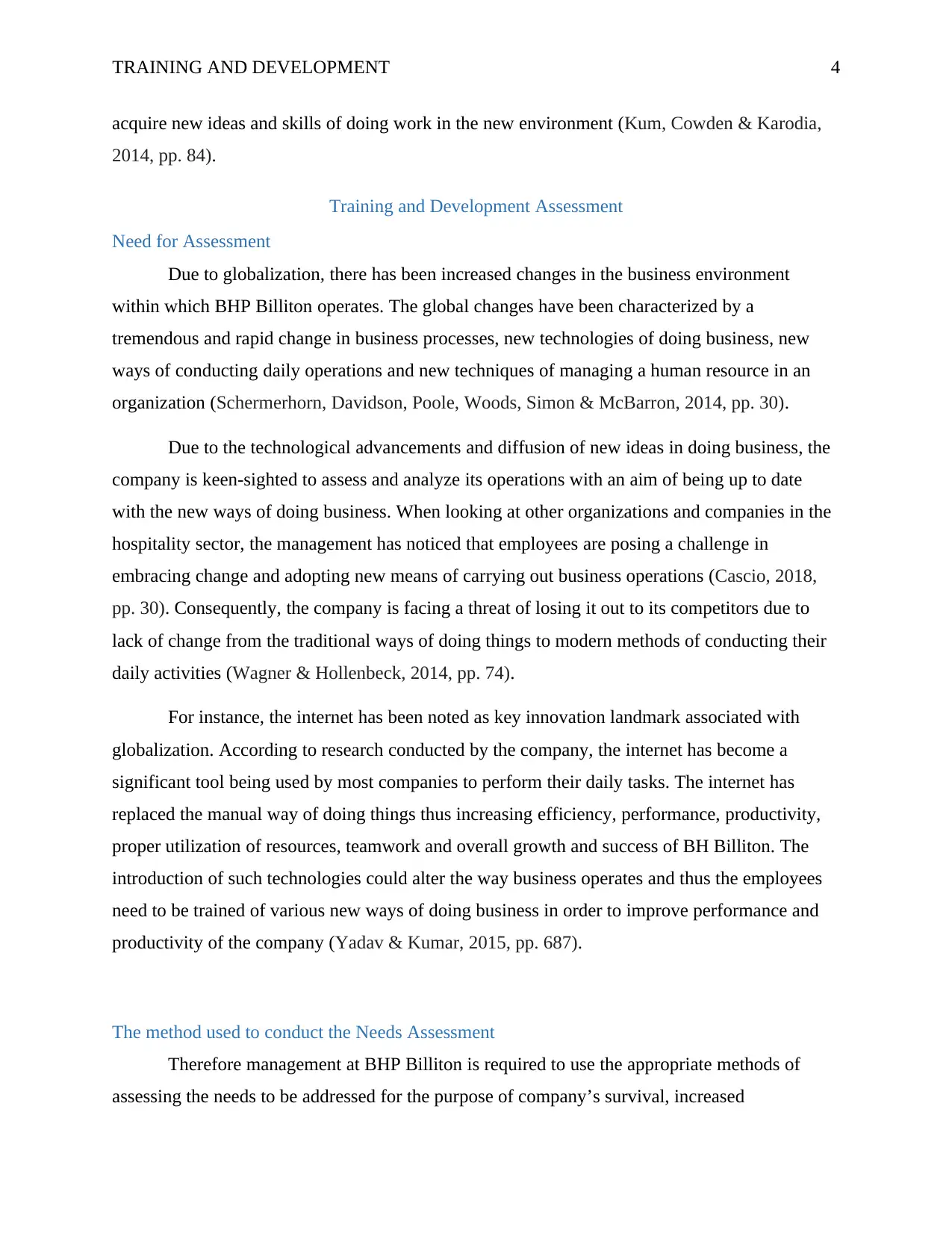
TRAINING AND DEVELOPMENT 4
acquire new ideas and skills of doing work in the new environment (Kum, Cowden & Karodia,
2014, pp. 84).
Training and Development Assessment
Need for Assessment
Due to globalization, there has been increased changes in the business environment
within which BHP Billiton operates. The global changes have been characterized by a
tremendous and rapid change in business processes, new technologies of doing business, new
ways of conducting daily operations and new techniques of managing a human resource in an
organization (Schermerhorn, Davidson, Poole, Woods, Simon & McBarron, 2014, pp. 30).
Due to the technological advancements and diffusion of new ideas in doing business, the
company is keen-sighted to assess and analyze its operations with an aim of being up to date
with the new ways of doing business. When looking at other organizations and companies in the
hospitality sector, the management has noticed that employees are posing a challenge in
embracing change and adopting new means of carrying out business operations (Cascio, 2018,
pp. 30). Consequently, the company is facing a threat of losing it out to its competitors due to
lack of change from the traditional ways of doing things to modern methods of conducting their
daily activities (Wagner & Hollenbeck, 2014, pp. 74).
For instance, the internet has been noted as key innovation landmark associated with
globalization. According to research conducted by the company, the internet has become a
significant tool being used by most companies to perform their daily tasks. The internet has
replaced the manual way of doing things thus increasing efficiency, performance, productivity,
proper utilization of resources, teamwork and overall growth and success of BH Billiton. The
introduction of such technologies could alter the way business operates and thus the employees
need to be trained of various new ways of doing business in order to improve performance and
productivity of the company (Yadav & Kumar, 2015, pp. 687).
The method used to conduct the Needs Assessment
Therefore management at BHP Billiton is required to use the appropriate methods of
assessing the needs to be addressed for the purpose of company’s survival, increased
acquire new ideas and skills of doing work in the new environment (Kum, Cowden & Karodia,
2014, pp. 84).
Training and Development Assessment
Need for Assessment
Due to globalization, there has been increased changes in the business environment
within which BHP Billiton operates. The global changes have been characterized by a
tremendous and rapid change in business processes, new technologies of doing business, new
ways of conducting daily operations and new techniques of managing a human resource in an
organization (Schermerhorn, Davidson, Poole, Woods, Simon & McBarron, 2014, pp. 30).
Due to the technological advancements and diffusion of new ideas in doing business, the
company is keen-sighted to assess and analyze its operations with an aim of being up to date
with the new ways of doing business. When looking at other organizations and companies in the
hospitality sector, the management has noticed that employees are posing a challenge in
embracing change and adopting new means of carrying out business operations (Cascio, 2018,
pp. 30). Consequently, the company is facing a threat of losing it out to its competitors due to
lack of change from the traditional ways of doing things to modern methods of conducting their
daily activities (Wagner & Hollenbeck, 2014, pp. 74).
For instance, the internet has been noted as key innovation landmark associated with
globalization. According to research conducted by the company, the internet has become a
significant tool being used by most companies to perform their daily tasks. The internet has
replaced the manual way of doing things thus increasing efficiency, performance, productivity,
proper utilization of resources, teamwork and overall growth and success of BH Billiton. The
introduction of such technologies could alter the way business operates and thus the employees
need to be trained of various new ways of doing business in order to improve performance and
productivity of the company (Yadav & Kumar, 2015, pp. 687).
The method used to conduct the Needs Assessment
Therefore management at BHP Billiton is required to use the appropriate methods of
assessing the needs to be addressed for the purpose of company’s survival, increased
Paraphrase This Document
Need a fresh take? Get an instant paraphrase of this document with our AI Paraphraser
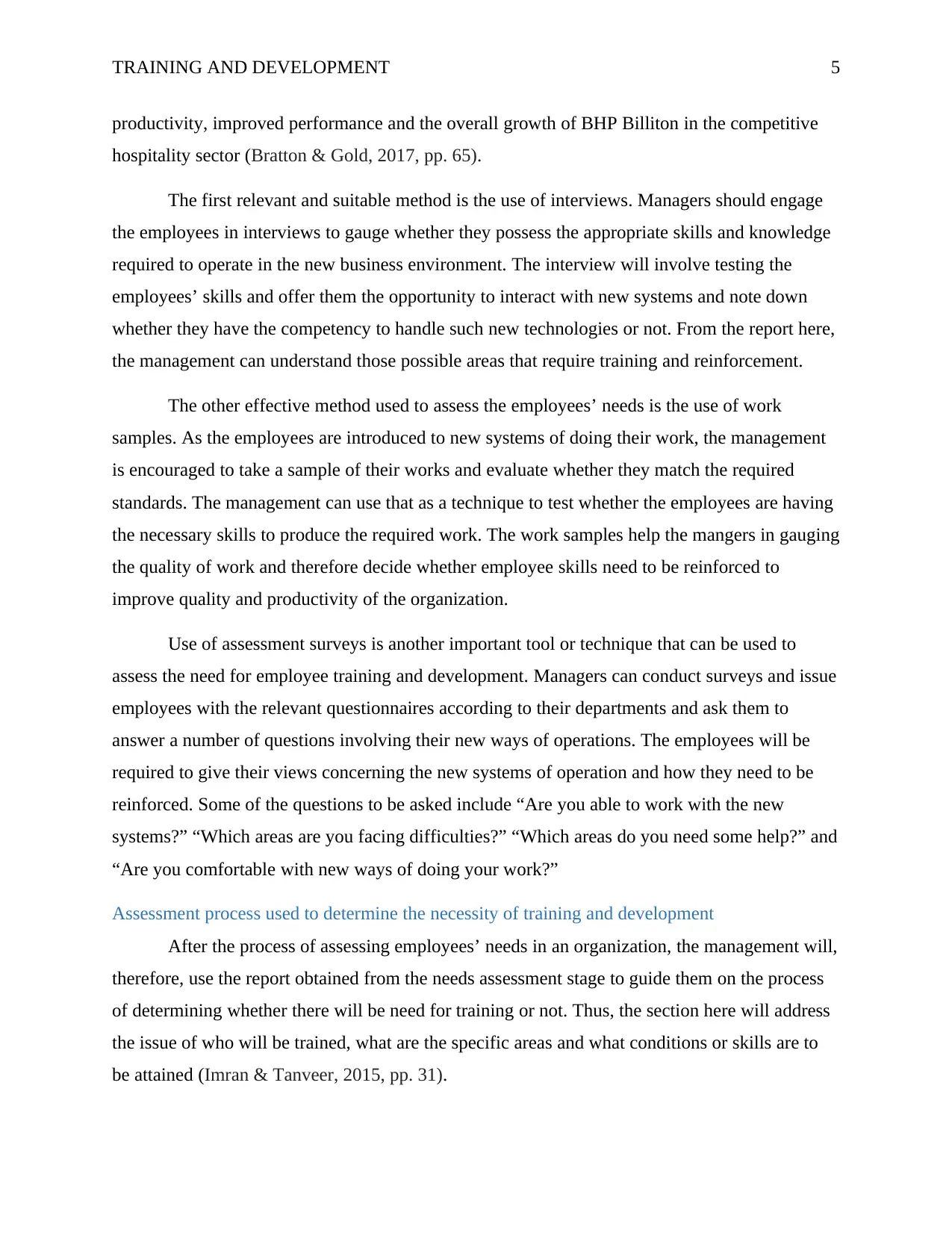
TRAINING AND DEVELOPMENT 5
productivity, improved performance and the overall growth of BHP Billiton in the competitive
hospitality sector (Bratton & Gold, 2017, pp. 65).
The first relevant and suitable method is the use of interviews. Managers should engage
the employees in interviews to gauge whether they possess the appropriate skills and knowledge
required to operate in the new business environment. The interview will involve testing the
employees’ skills and offer them the opportunity to interact with new systems and note down
whether they have the competency to handle such new technologies or not. From the report here,
the management can understand those possible areas that require training and reinforcement.
The other effective method used to assess the employees’ needs is the use of work
samples. As the employees are introduced to new systems of doing their work, the management
is encouraged to take a sample of their works and evaluate whether they match the required
standards. The management can use that as a technique to test whether the employees are having
the necessary skills to produce the required work. The work samples help the mangers in gauging
the quality of work and therefore decide whether employee skills need to be reinforced to
improve quality and productivity of the organization.
Use of assessment surveys is another important tool or technique that can be used to
assess the need for employee training and development. Managers can conduct surveys and issue
employees with the relevant questionnaires according to their departments and ask them to
answer a number of questions involving their new ways of operations. The employees will be
required to give their views concerning the new systems of operation and how they need to be
reinforced. Some of the questions to be asked include “Are you able to work with the new
systems?” “Which areas are you facing difficulties?” “Which areas do you need some help?” and
“Are you comfortable with new ways of doing your work?”
Assessment process used to determine the necessity of training and development
After the process of assessing employees’ needs in an organization, the management will,
therefore, use the report obtained from the needs assessment stage to guide them on the process
of determining whether there will be need for training or not. Thus, the section here will address
the issue of who will be trained, what are the specific areas and what conditions or skills are to
be attained (Imran & Tanveer, 2015, pp. 31).
productivity, improved performance and the overall growth of BHP Billiton in the competitive
hospitality sector (Bratton & Gold, 2017, pp. 65).
The first relevant and suitable method is the use of interviews. Managers should engage
the employees in interviews to gauge whether they possess the appropriate skills and knowledge
required to operate in the new business environment. The interview will involve testing the
employees’ skills and offer them the opportunity to interact with new systems and note down
whether they have the competency to handle such new technologies or not. From the report here,
the management can understand those possible areas that require training and reinforcement.
The other effective method used to assess the employees’ needs is the use of work
samples. As the employees are introduced to new systems of doing their work, the management
is encouraged to take a sample of their works and evaluate whether they match the required
standards. The management can use that as a technique to test whether the employees are having
the necessary skills to produce the required work. The work samples help the mangers in gauging
the quality of work and therefore decide whether employee skills need to be reinforced to
improve quality and productivity of the organization.
Use of assessment surveys is another important tool or technique that can be used to
assess the need for employee training and development. Managers can conduct surveys and issue
employees with the relevant questionnaires according to their departments and ask them to
answer a number of questions involving their new ways of operations. The employees will be
required to give their views concerning the new systems of operation and how they need to be
reinforced. Some of the questions to be asked include “Are you able to work with the new
systems?” “Which areas are you facing difficulties?” “Which areas do you need some help?” and
“Are you comfortable with new ways of doing your work?”
Assessment process used to determine the necessity of training and development
After the process of assessing employees’ needs in an organization, the management will,
therefore, use the report obtained from the needs assessment stage to guide them on the process
of determining whether there will be need for training or not. Thus, the section here will address
the issue of who will be trained, what are the specific areas and what conditions or skills are to
be attained (Imran & Tanveer, 2015, pp. 31).
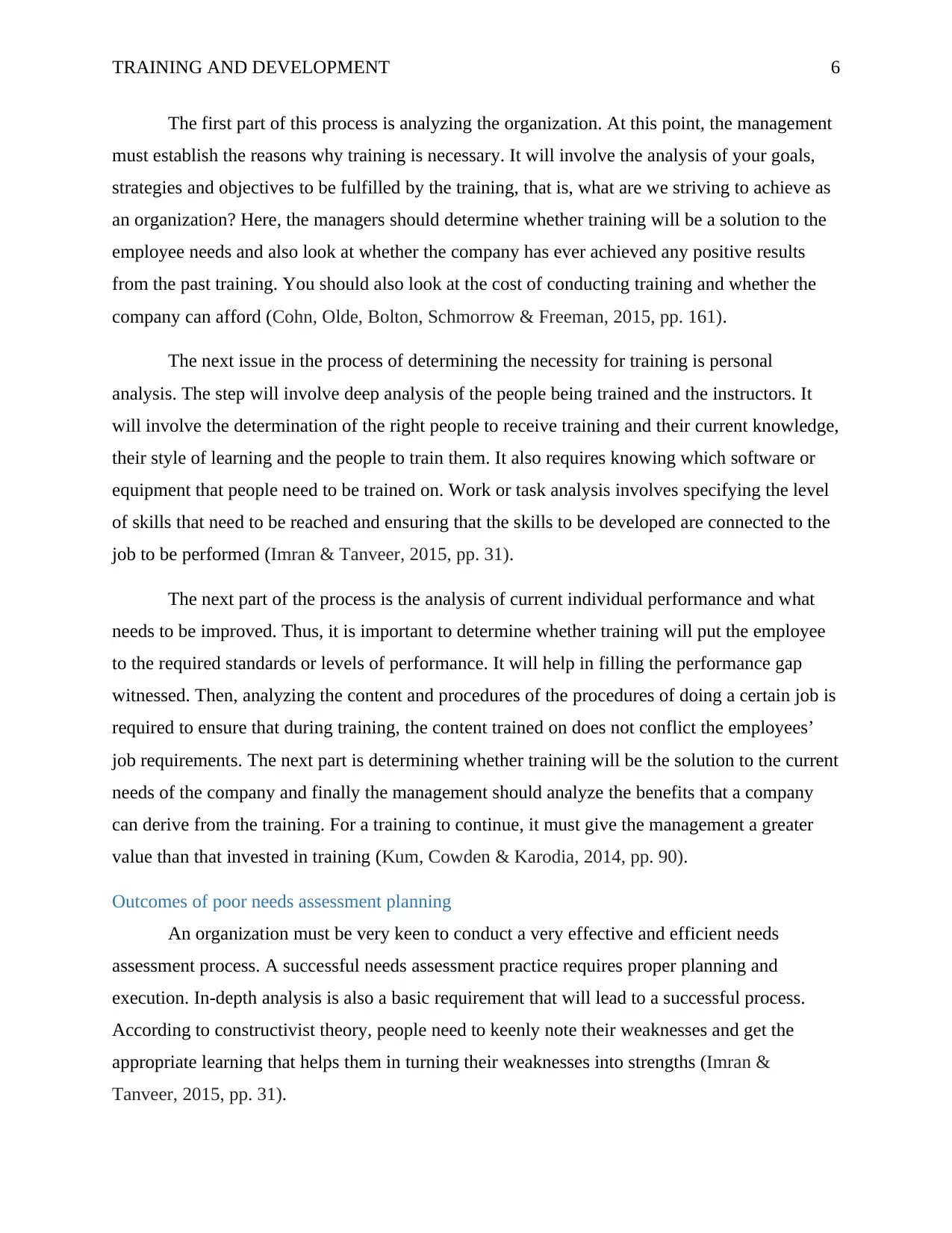
TRAINING AND DEVELOPMENT 6
The first part of this process is analyzing the organization. At this point, the management
must establish the reasons why training is necessary. It will involve the analysis of your goals,
strategies and objectives to be fulfilled by the training, that is, what are we striving to achieve as
an organization? Here, the managers should determine whether training will be a solution to the
employee needs and also look at whether the company has ever achieved any positive results
from the past training. You should also look at the cost of conducting training and whether the
company can afford (Cohn, Olde, Bolton, Schmorrow & Freeman, 2015, pp. 161).
The next issue in the process of determining the necessity for training is personal
analysis. The step will involve deep analysis of the people being trained and the instructors. It
will involve the determination of the right people to receive training and their current knowledge,
their style of learning and the people to train them. It also requires knowing which software or
equipment that people need to be trained on. Work or task analysis involves specifying the level
of skills that need to be reached and ensuring that the skills to be developed are connected to the
job to be performed (Imran & Tanveer, 2015, pp. 31).
The next part of the process is the analysis of current individual performance and what
needs to be improved. Thus, it is important to determine whether training will put the employee
to the required standards or levels of performance. It will help in filling the performance gap
witnessed. Then, analyzing the content and procedures of the procedures of doing a certain job is
required to ensure that during training, the content trained on does not conflict the employees’
job requirements. The next part is determining whether training will be the solution to the current
needs of the company and finally the management should analyze the benefits that a company
can derive from the training. For a training to continue, it must give the management a greater
value than that invested in training (Kum, Cowden & Karodia, 2014, pp. 90).
Outcomes of poor needs assessment planning
An organization must be very keen to conduct a very effective and efficient needs
assessment process. A successful needs assessment practice requires proper planning and
execution. In-depth analysis is also a basic requirement that will lead to a successful process.
According to constructivist theory, people need to keenly note their weaknesses and get the
appropriate learning that helps them in turning their weaknesses into strengths (Imran &
Tanveer, 2015, pp. 31).
The first part of this process is analyzing the organization. At this point, the management
must establish the reasons why training is necessary. It will involve the analysis of your goals,
strategies and objectives to be fulfilled by the training, that is, what are we striving to achieve as
an organization? Here, the managers should determine whether training will be a solution to the
employee needs and also look at whether the company has ever achieved any positive results
from the past training. You should also look at the cost of conducting training and whether the
company can afford (Cohn, Olde, Bolton, Schmorrow & Freeman, 2015, pp. 161).
The next issue in the process of determining the necessity for training is personal
analysis. The step will involve deep analysis of the people being trained and the instructors. It
will involve the determination of the right people to receive training and their current knowledge,
their style of learning and the people to train them. It also requires knowing which software or
equipment that people need to be trained on. Work or task analysis involves specifying the level
of skills that need to be reached and ensuring that the skills to be developed are connected to the
job to be performed (Imran & Tanveer, 2015, pp. 31).
The next part of the process is the analysis of current individual performance and what
needs to be improved. Thus, it is important to determine whether training will put the employee
to the required standards or levels of performance. It will help in filling the performance gap
witnessed. Then, analyzing the content and procedures of the procedures of doing a certain job is
required to ensure that during training, the content trained on does not conflict the employees’
job requirements. The next part is determining whether training will be the solution to the current
needs of the company and finally the management should analyze the benefits that a company
can derive from the training. For a training to continue, it must give the management a greater
value than that invested in training (Kum, Cowden & Karodia, 2014, pp. 90).
Outcomes of poor needs assessment planning
An organization must be very keen to conduct a very effective and efficient needs
assessment process. A successful needs assessment practice requires proper planning and
execution. In-depth analysis is also a basic requirement that will lead to a successful process.
According to constructivist theory, people need to keenly note their weaknesses and get the
appropriate learning that helps them in turning their weaknesses into strengths (Imran &
Tanveer, 2015, pp. 31).
⊘ This is a preview!⊘
Do you want full access?
Subscribe today to unlock all pages.

Trusted by 1+ million students worldwide
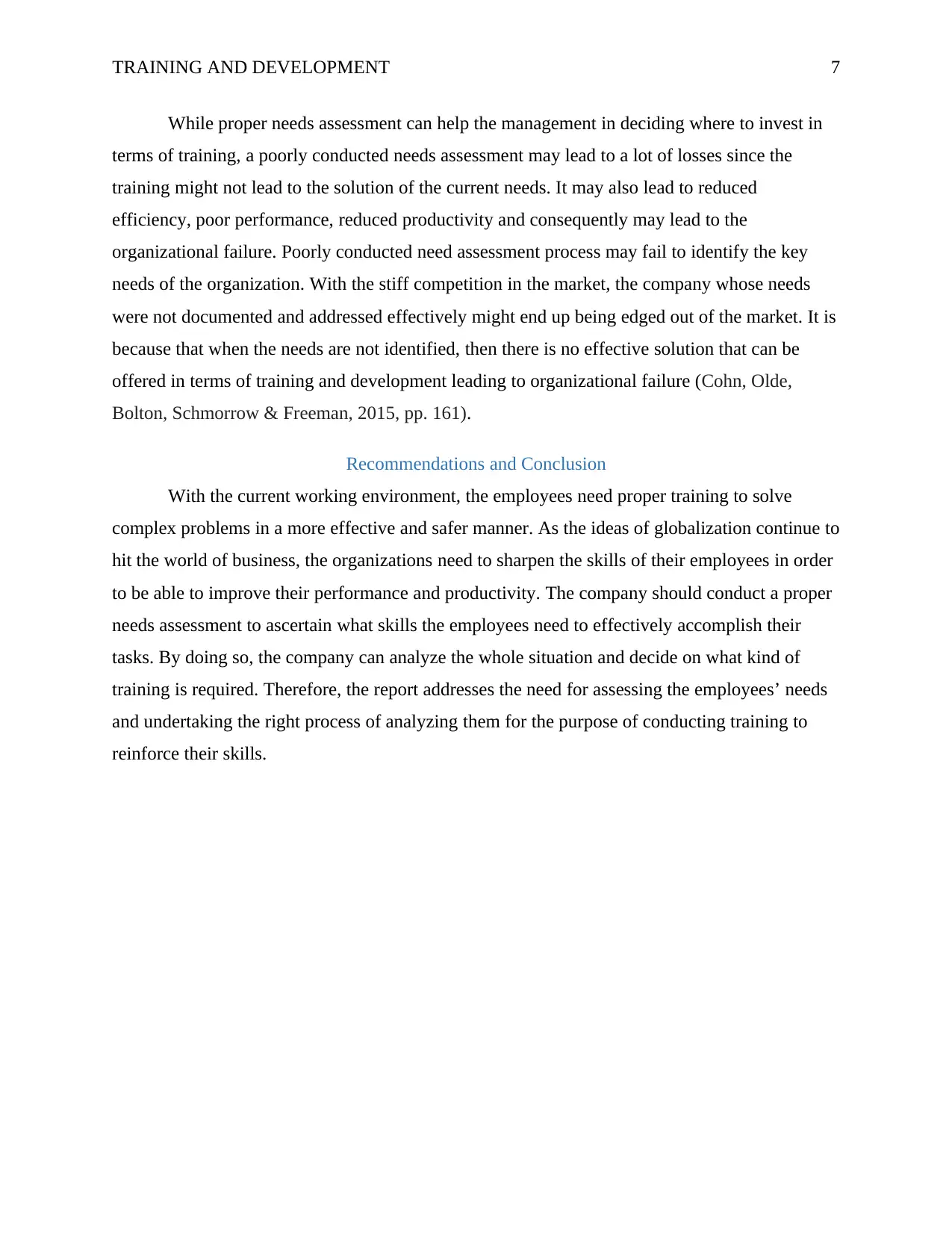
TRAINING AND DEVELOPMENT 7
While proper needs assessment can help the management in deciding where to invest in
terms of training, a poorly conducted needs assessment may lead to a lot of losses since the
training might not lead to the solution of the current needs. It may also lead to reduced
efficiency, poor performance, reduced productivity and consequently may lead to the
organizational failure. Poorly conducted need assessment process may fail to identify the key
needs of the organization. With the stiff competition in the market, the company whose needs
were not documented and addressed effectively might end up being edged out of the market. It is
because that when the needs are not identified, then there is no effective solution that can be
offered in terms of training and development leading to organizational failure (Cohn, Olde,
Bolton, Schmorrow & Freeman, 2015, pp. 161).
Recommendations and Conclusion
With the current working environment, the employees need proper training to solve
complex problems in a more effective and safer manner. As the ideas of globalization continue to
hit the world of business, the organizations need to sharpen the skills of their employees in order
to be able to improve their performance and productivity. The company should conduct a proper
needs assessment to ascertain what skills the employees need to effectively accomplish their
tasks. By doing so, the company can analyze the whole situation and decide on what kind of
training is required. Therefore, the report addresses the need for assessing the employees’ needs
and undertaking the right process of analyzing them for the purpose of conducting training to
reinforce their skills.
While proper needs assessment can help the management in deciding where to invest in
terms of training, a poorly conducted needs assessment may lead to a lot of losses since the
training might not lead to the solution of the current needs. It may also lead to reduced
efficiency, poor performance, reduced productivity and consequently may lead to the
organizational failure. Poorly conducted need assessment process may fail to identify the key
needs of the organization. With the stiff competition in the market, the company whose needs
were not documented and addressed effectively might end up being edged out of the market. It is
because that when the needs are not identified, then there is no effective solution that can be
offered in terms of training and development leading to organizational failure (Cohn, Olde,
Bolton, Schmorrow & Freeman, 2015, pp. 161).
Recommendations and Conclusion
With the current working environment, the employees need proper training to solve
complex problems in a more effective and safer manner. As the ideas of globalization continue to
hit the world of business, the organizations need to sharpen the skills of their employees in order
to be able to improve their performance and productivity. The company should conduct a proper
needs assessment to ascertain what skills the employees need to effectively accomplish their
tasks. By doing so, the company can analyze the whole situation and decide on what kind of
training is required. Therefore, the report addresses the need for assessing the employees’ needs
and undertaking the right process of analyzing them for the purpose of conducting training to
reinforce their skills.
Paraphrase This Document
Need a fresh take? Get an instant paraphrase of this document with our AI Paraphraser
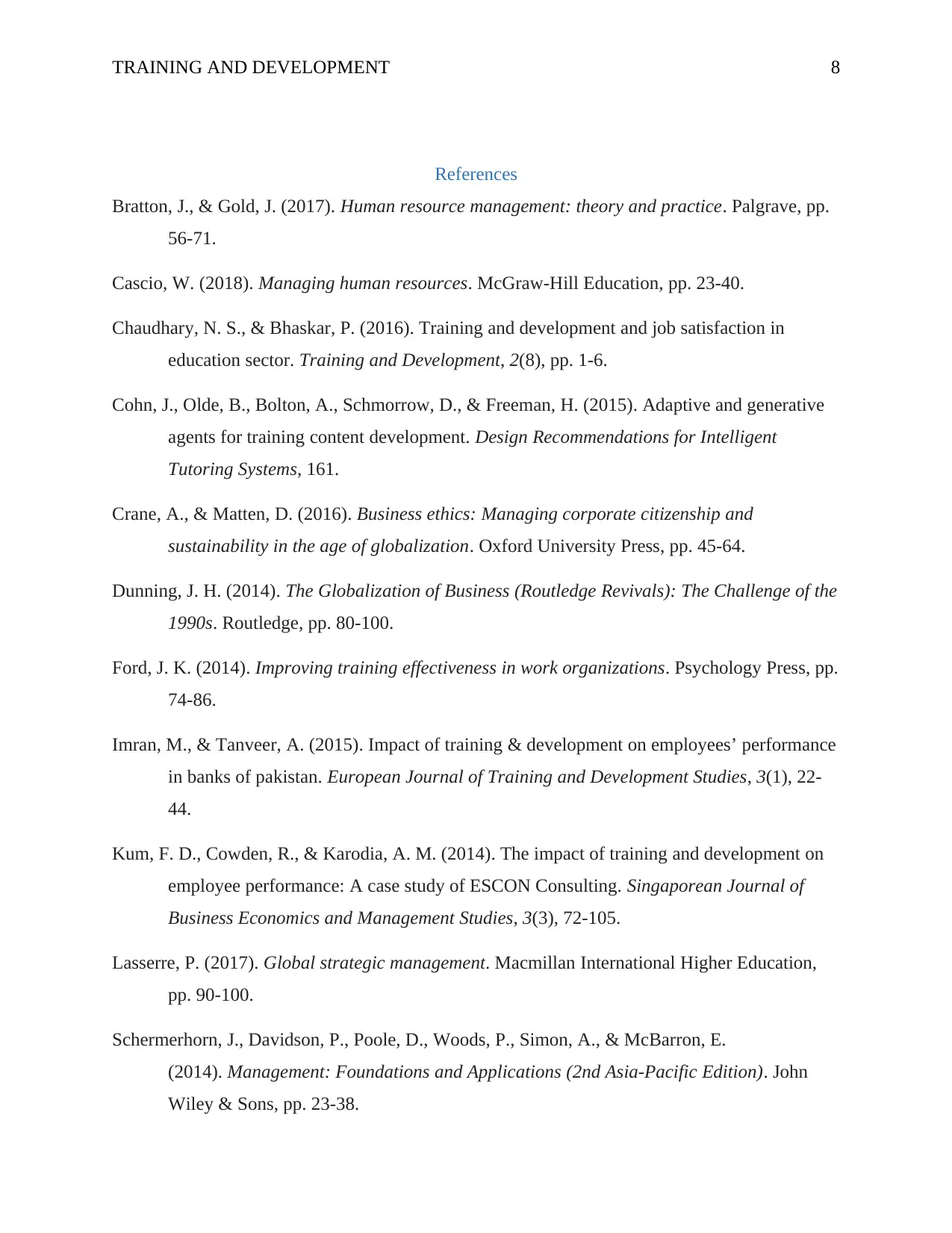
TRAINING AND DEVELOPMENT 8
References
Bratton, J., & Gold, J. (2017). Human resource management: theory and practice. Palgrave, pp.
56-71.
Cascio, W. (2018). Managing human resources. McGraw-Hill Education, pp. 23-40.
Chaudhary, N. S., & Bhaskar, P. (2016). Training and development and job satisfaction in
education sector. Training and Development, 2(8), pp. 1-6.
Cohn, J., Olde, B., Bolton, A., Schmorrow, D., & Freeman, H. (2015). Adaptive and generative
agents for training content development. Design Recommendations for Intelligent
Tutoring Systems, 161.
Crane, A., & Matten, D. (2016). Business ethics: Managing corporate citizenship and
sustainability in the age of globalization. Oxford University Press, pp. 45-64.
Dunning, J. H. (2014). The Globalization of Business (Routledge Revivals): The Challenge of the
1990s. Routledge, pp. 80-100.
Ford, J. K. (2014). Improving training effectiveness in work organizations. Psychology Press, pp.
74-86.
Imran, M., & Tanveer, A. (2015). Impact of training & development on employees’ performance
in banks of pakistan. European Journal of Training and Development Studies, 3(1), 22-
44.
Kum, F. D., Cowden, R., & Karodia, A. M. (2014). The impact of training and development on
employee performance: A case study of ESCON Consulting. Singaporean Journal of
Business Economics and Management Studies, 3(3), 72-105.
Lasserre, P. (2017). Global strategic management. Macmillan International Higher Education,
pp. 90-100.
Schermerhorn, J., Davidson, P., Poole, D., Woods, P., Simon, A., & McBarron, E.
(2014). Management: Foundations and Applications (2nd Asia-Pacific Edition). John
Wiley & Sons, pp. 23-38.
References
Bratton, J., & Gold, J. (2017). Human resource management: theory and practice. Palgrave, pp.
56-71.
Cascio, W. (2018). Managing human resources. McGraw-Hill Education, pp. 23-40.
Chaudhary, N. S., & Bhaskar, P. (2016). Training and development and job satisfaction in
education sector. Training and Development, 2(8), pp. 1-6.
Cohn, J., Olde, B., Bolton, A., Schmorrow, D., & Freeman, H. (2015). Adaptive and generative
agents for training content development. Design Recommendations for Intelligent
Tutoring Systems, 161.
Crane, A., & Matten, D. (2016). Business ethics: Managing corporate citizenship and
sustainability in the age of globalization. Oxford University Press, pp. 45-64.
Dunning, J. H. (2014). The Globalization of Business (Routledge Revivals): The Challenge of the
1990s. Routledge, pp. 80-100.
Ford, J. K. (2014). Improving training effectiveness in work organizations. Psychology Press, pp.
74-86.
Imran, M., & Tanveer, A. (2015). Impact of training & development on employees’ performance
in banks of pakistan. European Journal of Training and Development Studies, 3(1), 22-
44.
Kum, F. D., Cowden, R., & Karodia, A. M. (2014). The impact of training and development on
employee performance: A case study of ESCON Consulting. Singaporean Journal of
Business Economics and Management Studies, 3(3), 72-105.
Lasserre, P. (2017). Global strategic management. Macmillan International Higher Education,
pp. 90-100.
Schermerhorn, J., Davidson, P., Poole, D., Woods, P., Simon, A., & McBarron, E.
(2014). Management: Foundations and Applications (2nd Asia-Pacific Edition). John
Wiley & Sons, pp. 23-38.
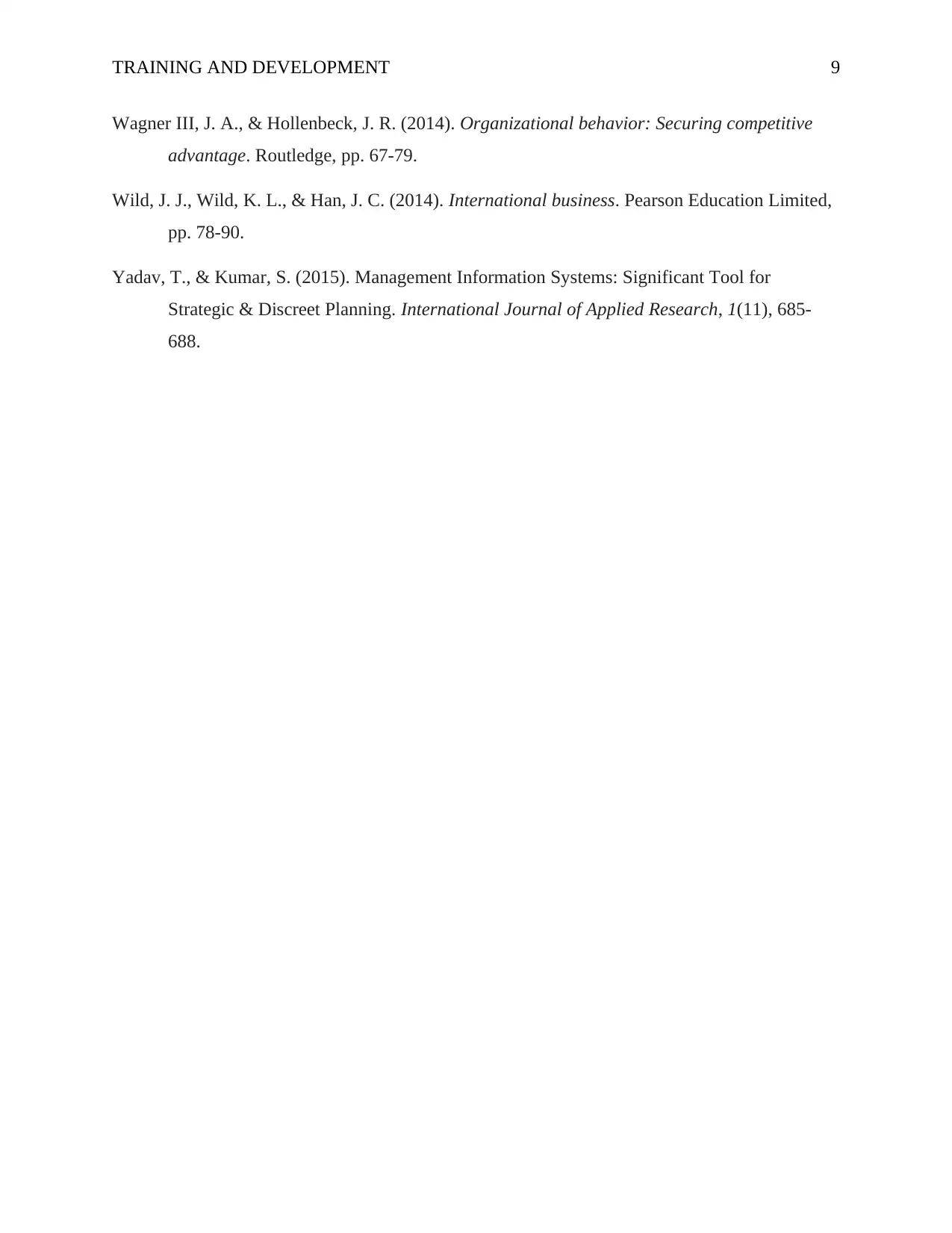
TRAINING AND DEVELOPMENT 9
Wagner III, J. A., & Hollenbeck, J. R. (2014). Organizational behavior: Securing competitive
advantage. Routledge, pp. 67-79.
Wild, J. J., Wild, K. L., & Han, J. C. (2014). International business. Pearson Education Limited,
pp. 78-90.
Yadav, T., & Kumar, S. (2015). Management Information Systems: Significant Tool for
Strategic & Discreet Planning. International Journal of Applied Research, 1(11), 685-
688.
Wagner III, J. A., & Hollenbeck, J. R. (2014). Organizational behavior: Securing competitive
advantage. Routledge, pp. 67-79.
Wild, J. J., Wild, K. L., & Han, J. C. (2014). International business. Pearson Education Limited,
pp. 78-90.
Yadav, T., & Kumar, S. (2015). Management Information Systems: Significant Tool for
Strategic & Discreet Planning. International Journal of Applied Research, 1(11), 685-
688.
⊘ This is a preview!⊘
Do you want full access?
Subscribe today to unlock all pages.

Trusted by 1+ million students worldwide
1 out of 9
Related Documents
Your All-in-One AI-Powered Toolkit for Academic Success.
+13062052269
info@desklib.com
Available 24*7 on WhatsApp / Email
![[object Object]](/_next/static/media/star-bottom.7253800d.svg)
Unlock your academic potential
Copyright © 2020–2025 A2Z Services. All Rights Reserved. Developed and managed by ZUCOL.





